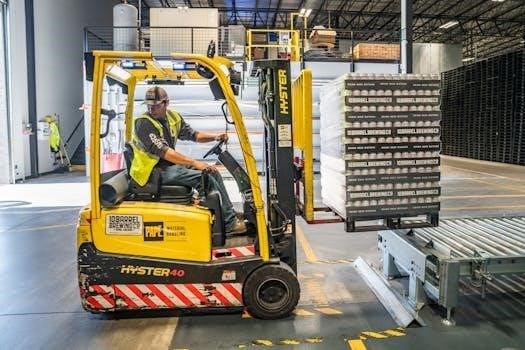
Manual Forklifts⁚ An Overview
Manual forklifts are indispensable tools for material handling. They offer a cost-effective solution for moving loads in warehouses and retail stores. Their design emphasizes ease of use and minimal maintenance, making them ideal for smaller operations.
Types of Manual Forklifts
Manual forklifts primarily include pallet jacks designed for moving lighter goods. Adjustable fork models also exist, accommodating various pallet sizes. These types suit different operational needs within smaller warehouses.
Pallet Jacks (Manual)
Manual pallet jacks are essential tools for transporting palletized loads over short distances. They represent a cost-effective solution for businesses needing to move lighter goods efficiently. These jacks, also known as pallet trucks, come in simple designs that prioritize ease of use. Their manual operation requires minimal training, making them accessible to most workers. They are particularly useful in small warehouses and retail stores where the movement of goods is frequent but the distances are limited. Manual pallet jacks eliminate the need for electric power, reducing operational costs and maintenance requirements.
Key advantages include their affordability, ease of maneuverability, and low maintenance needs. They are ideal for environments where space is limited, as they can navigate narrow aisles and tight corners with ease. The simplicity of their design ensures that they are reliable and durable, even under constant use. Regular maintenance typically involves basic checks and lubrication, which can be easily performed by in-house staff.
However, manual pallet jacks are best suited for lighter loads and shorter distances. For heavier loads or longer transport routes, electric pallet jacks or other types of forklifts may be more appropriate. Despite these limitations, manual pallet jacks remain a staple in many businesses due to their practicality and cost-effectiveness. Their widespread use underscores their value in streamlining material handling processes in various industries. They are a practical alternative for businesses seeking to minimize operational expenses while maintaining efficiency in moving goods.
Adjustable Fork Manual Forklifts
Adjustable fork manual forklifts provide enhanced versatility in material handling, allowing operators to adapt to different pallet sizes and load types. These forklifts feature forks that can be adjusted manually to accommodate various dimensions, making them suitable for warehouses and distribution centers dealing with diverse products. The adjustable fork design ensures that operators can securely lift and transport different types of pallets without the need for multiple specialized forklifts. This adaptability reduces the overall equipment costs and simplifies the material handling process.
The manual adjustment mechanism is typically straightforward, allowing operators to quickly change the fork spacing to match the load requirements. This feature is particularly useful in environments where the pallet sizes vary frequently. Adjustable fork manual forklifts are designed to handle light to moderate loads, making them ideal for smaller warehouses and retail stores. Their manual operation requires minimal training, making them easy to integrate into existing workflows.
Key advantages include their adaptability, cost-effectiveness, and ease of maintenance; They eliminate the need for multiple forklifts, reducing the overall equipment footprint and operational costs. Regular maintenance typically involves basic checks and lubrication, ensuring that the forklifts remain in good working condition. However, these forklifts are best suited for manual tasks and may not be suitable for very heavy loads or high-volume operations. Despite these limitations, adjustable fork manual forklifts offer a practical and efficient solution for businesses seeking to optimize their material handling processes. Their ability to handle diverse pallet sizes makes them a valuable asset in any warehouse or distribution center, ensuring smooth and efficient operations.

Applications of Manual Forklifts
Manual forklifts find use in various settings due to their cost-effectiveness and ease of operation. They are particularly well-suited for small warehouses and retail stores where handling lighter loads is the primary requirement.
Use in Small Warehouses
Small warehouses benefit significantly from the use of manual forklifts due to their compact design and maneuverability. These forklifts are well-suited for navigating tight spaces and narrow aisles, allowing for efficient material handling in environments where space is limited; Manual forklifts are particularly useful for tasks such as loading and unloading goods from delivery trucks, organizing inventory, and moving materials between different areas of the warehouse.
The cost-effectiveness of manual forklifts makes them an attractive option for small warehouses operating with limited budgets. Unlike electric or internal combustion (IC) forklifts, manual forklifts do not require fuel or electricity, reducing operational expenses. Additionally, the maintenance requirements for manual forklifts are typically lower than those of powered forklifts, further contributing to cost savings. This makes them a practical choice for businesses looking to minimize their overhead costs while maintaining efficient material handling processes.
Furthermore, the ease of use of manual forklifts simplifies training requirements, allowing warehouse staff to quickly become proficient in their operation. This reduces the time and resources needed for training programs, enabling employees to focus on other essential tasks. The straightforward design of manual forklifts also minimizes the risk of operational errors, promoting a safer working environment within the warehouse. By providing a reliable and user-friendly material handling solution, manual forklifts contribute to increased productivity and improved overall efficiency in small warehouse settings.
In addition to their practical advantages, manual forklifts also offer environmental benefits. As they do not rely on fossil fuels or electricity, they produce no emissions during operation, making them a sustainable choice for businesses committed to reducing their environmental footprint. This aligns with the growing trend of eco-conscious practices in the business world, enhancing the reputation of companies that prioritize environmental responsibility. By incorporating manual forklifts into their operations, small warehouses can demonstrate their commitment to sustainability while enjoying the operational benefits they provide.
Retail Store Applications
Retail stores find manual forklifts exceptionally useful for various material handling tasks within their limited spaces. These forklifts are ideal for moving merchandise from the receiving area to the sales floor, organizing stock in storage rooms, and replenishing shelves. The compact design and excellent maneuverability of manual forklifts make them perfect for navigating narrow aisles and tight corners, ensuring efficient stock management even in crowded retail environments.
The cost-effectiveness of manual forklifts is a significant advantage for retail stores operating with tight budgets. Unlike electric or IC forklifts, manual forklifts do not require electricity or fuel, leading to reduced operating costs. The minimal maintenance requirements of manual forklifts further contribute to cost savings, making them a practical choice for retailers seeking to optimize their expenses while maintaining smooth store operations. This affordability allows retail stores to allocate resources to other critical areas, such as marketing or customer service.
Furthermore, the ease of use of manual forklifts simplifies training, enabling retail staff to quickly become proficient in their operation. This minimizes the time and resources spent on training programs, allowing employees to focus on customer service and sales. The straightforward design of manual forklifts also reduces the risk of operational errors, creating a safer working environment for both employees and customers. By providing a reliable and user-friendly material handling solution, manual forklifts enhance productivity and improve the overall efficiency of retail store operations.
In addition to their operational benefits, manual forklifts also contribute to a quieter and more pleasant shopping environment. Unlike noisy electric or IC forklifts, manual forklifts operate silently, minimizing disruptions to customers and creating a more comfortable atmosphere. This is particularly important in retail settings where customer experience is paramount. By choosing manual forklifts, retail stores can demonstrate their commitment to providing a positive shopping environment while efficiently managing their inventory and stock levels. This can enhance customer satisfaction and improve overall store performance.

Load Capacity of Manual Forklifts
The load capacity of manual forklifts is a crucial factor to consider when evaluating their suitability for specific material handling tasks. Generally, most manual forklifts can handle loads ranging from 1,000 to 5,000 pounds, making them well-suited for light to moderate material handling operations in various environments. This capacity is sufficient for moving palletized goods, equipment, and materials within warehouses, retail stores, and small manufacturing facilities.
While manual forklifts may not match the higher load capacities of electric or IC forklifts, their capacity is adequate for many common tasks. The specific load capacity of a manual forklift depends on its design, construction materials, and intended use. It’s important to consult the manufacturer’s specifications to determine the exact load capacity of a particular model and ensure that it meets the requirements of the intended application. Overloading a manual forklift can lead to equipment damage, safety hazards, and operational inefficiencies.
For operations involving heavier loads, alternative types of forklifts with higher capacities may be necessary. However, for businesses with lighter material handling needs, manual forklifts offer a cost-effective and efficient solution. Their lower upfront cost and minimal maintenance requirements make them an attractive option for smaller businesses or those with limited budgets. By carefully assessing the load capacity requirements of their operations, businesses can determine whether manual forklifts are a suitable choice or if other types of forklifts are needed.
In addition to the overall load capacity, it’s also important to consider the load distribution and stability of manual forklifts. Proper load distribution ensures that the weight is evenly distributed across the forks, preventing tipping or instability. Operators should be trained to load and unload manual forklifts safely, following best practices for load placement and weight distribution. By adhering to these guidelines, businesses can maximize the safety and efficiency of their material handling operations while utilizing manual forklifts within their specified load capacity limits. Regular inspections and maintenance can also help ensure that manual forklifts are operating safely and efficiently.

Ease of Use and Training Requirements
Manual forklifts are renowned for their ease of use, requiring minimal training for operators to become proficient. Unlike their electric or internal combustion counterparts, manual forklifts do not involve complex controls or intricate systems. The operational simplicity of manual forklifts translates into a shorter learning curve for new operators, reducing the time and resources needed for training programs.
The primary controls on a manual forklift typically consist of a steering mechanism, lifting levers, and brakes. These controls are straightforward and intuitive, allowing operators to quickly grasp the fundamentals of operating the equipment. The absence of sophisticated electronics or engine components simplifies the operation and reduces the potential for technical issues.
While formal certification may not be mandatory for manual forklift operation in all jurisdictions, basic training is essential to ensure safe and efficient use. Training programs should cover topics such as proper lifting techniques, load handling procedures, and safety precautions. Operators should also be instructed on how to inspect the forklift for any signs of damage or wear before each use. Regular refresher training can help reinforce safe operating practices and address any emerging issues.
The minimal training requirements associated with manual forklifts can be a significant advantage for businesses with limited resources or a high turnover of employees. The reduced training burden translates into lower costs and increased operational flexibility. However, it’s crucial to emphasize that even with simple equipment like manual forklifts, safety should always be the top priority. Operators should be thoroughly trained on safe operating practices, and regular inspections and maintenance should be performed to ensure the equipment is in good working condition. By prioritizing safety and providing adequate training, businesses can maximize the benefits of manual forklifts while minimizing the risk of accidents or injuries. The straightforward nature of manual forklifts makes them an attractive option for a variety of applications.

Maintenance of Manual Forklifts
Manual forklifts, distinguished by their simple mechanical designs, generally require less maintenance compared to electric or engine-powered models. This reduced maintenance translates to lower long-term costs and minimized downtime, making them an appealing option for operations seeking cost-effective material handling solutions. The core of manual forklift maintenance revolves around basic upkeep and routine inspections.
Regular lubrication of moving parts is crucial for ensuring smooth operation and preventing premature wear. Components such as wheels, axles, and lifting mechanisms should be lubricated according to the manufacturer’s recommendations. Inspecting the wheels for damage or wear is also essential, as worn or damaged wheels can compromise stability and maneuverability. Tire pressure, if applicable, should be checked and maintained at the recommended level.
The hydraulic system, if present, should be inspected for leaks or damage. Hydraulic fluid levels should be checked regularly and replenished as needed. The lifting mechanism should be inspected for any signs of wear or damage, such as bent forks or cracked welds. Brakes, if equipped, should be tested regularly to ensure they are functioning properly.
A comprehensive maintenance checklist should be developed and followed to ensure that all critical components are inspected regularly. This checklist should include items such as lubrication points, wheel condition, hydraulic system integrity, and brake functionality. Keeping a detailed record of all maintenance activities can help track the performance of the forklift and identify any recurring issues.
While manual forklifts generally require less maintenance, neglecting routine upkeep can lead to costly repairs and reduced lifespan. By adhering to a regular maintenance schedule and addressing any issues promptly, businesses can ensure that their manual forklifts remain in good working condition and continue to provide reliable service for years to come. Proper maintenance not only extends the life of the equipment but also enhances safety and reduces the risk of accidents. It is a small price to pay for the benefits it provides.
Advantages of Manual Forklifts
Cost Considerations⁚ Upfront vs. Long-Term
When evaluating the economic feasibility of manual forklifts, it’s crucial to consider both the initial investment and the long-term operational costs. Manual forklifts generally have a lower upfront cost compared to their electric or engine-powered counterparts. This makes them an attractive option for businesses with limited budgets or those seeking to minimize initial capital expenditure. However, the total cost of ownership extends beyond the purchase price, encompassing maintenance, repairs, and operational expenses over the equipment’s lifespan.
One of the primary advantages of manual forklifts is their reduced maintenance requirements. With fewer moving parts and no complex electrical or engine components, the need for extensive repairs and specialized servicing is significantly lower. This translates to lower maintenance costs and reduced downtime, contributing to long-term savings. The simplicity of manual forklifts also means that repairs can often be performed by in-house personnel, further minimizing expenses.
Operational costs associated with manual forklifts are also generally lower than those of other types of forklifts. There are no fuel or electricity costs, eliminating the need for refueling or recharging. This not only reduces expenses but also simplifies logistics and eliminates the risk of running out of power during operation. Additionally, manual forklifts typically have a longer lifespan than powered models, further contributing to long-term cost savings.
However, it’s important to consider the potential impact on productivity. Manual forklifts require more physical effort from operators, which can lead to fatigue and reduced efficiency, especially during prolonged use. This may result in lower throughput and increased labor costs. Therefore, it’s essential to assess the specific operational needs and workload requirements before deciding on a manual forklift.